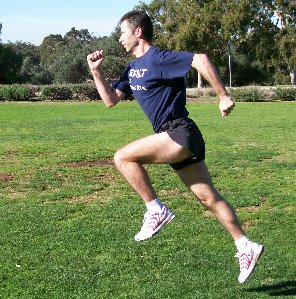Muscles are the most accessible way we have to see what our workouts do to our bodies. However, despite how many compliments you get from your Instagram pictures taken following your workouts, what matters is not what your muscles look like, but what they can do.
In the early days, it was the strength of a muscle that garnered all of the attention in the field of physical education. Tests of muscular strength have existed since at least the time of the ancient Olympics, when athletes were required to lift a ball of iron in order to qualify. In 1873, Dr. Dudley Sargent, a pioneer in physical education, initiated strength testing at Harvard University. It has since become an important tool in evaluating muscle characteristics. But if we want toned, sexy muscles or improved athletic performance, muscle strength is not enough. We need muscle power.
There are a number of lightning-fast steps that occur for muscles to contract and produce force, all starting with the central nervous system, including the transmission of a signal to a motor neuron, the release of a neurotransmitter (acetylcholine) at the neuromuscular junction, the depolarization of the muscle, the propagation of an action potential deep inside the muscle, the release of calcium ions from the muscle’s sarcoplasmic reticulum, the interaction between contractile proteins (actin and myosin), and the hydrolysis of ATP for muscle contraction.
To run fast, the central nervous system has to increase the number of motor units recruited and increase the frequency of stimulation of the motor units. Running fast is thus a strong stimulus for the central nervous system. Since most of a distance runner’s training is cardiovascular and metabolic in nature, the neuromuscular aspect of performance is often neglected. Stop neglecting it.
Strides are one of the things you can do to focus on the neuromuscular aspect of performance. Strides are 10- to 25-second (about 50 to 150 meters) controlled sprints. The purpose of strides is largely neuromuscular: to increase stride rate by recruiting fast-twitch motor units (muscle fibers), which increases speed and, more importantly, to increase stride length by increasing joint mobility (especially at the hip) and increasing leg muscle power, causing a greater propulsive thrust. The short bursts of speed also improve your coordination, running form, and running economy.
Strides, like other neuromuscular and technical training, should be performed at the beginning of a workout (after a thorough warm-up) or after an easy run, when you’re still fresh. The goal is to make fast movements efficient. Thus, doing strides after an interval workout that causes a large amount of fatigue defeats the purpose of the strides. When you’re fatigued, stride length naturally decreases. Any neuromuscular or power training requires greater recovery than endurance or metabolic training; therefore, take full recovery between strides. Taking only a few seconds of recovery between strides introduces a metabolic demand. Making strides too long also introduces a metabolic demand, so strides should not be longer than about 25 seconds, otherwise you’ll start to cause muscle acidosis.
When running strides, aim for a fast, smooth feeling. Don’t press to go fast—they should not feel like intervals. Rather, relax and focus on moving your legs quickly through the running cycle to increase stride rate, and (more importantly) extending your legs behind you from the hip to increase stride length. Take as much time as you need between each one to feel recovered. Do strides on a flat stretch of road, grass field, or track. Start with one day of strides per week and progress to 3 times per week. You’ll be faster in no time!
Don’t forget to check out the Run-Fit Specialist certification! I’m coming to teach it in a city near you! http://revo2lutionrunning.com/runfitspecialist

